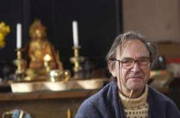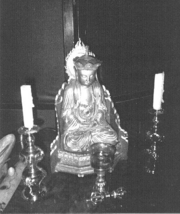Out of the corner of my eye I catch a glimpse of Bodhisattva Ksitigarbharaja seated upon the offering table in the Chan hall. As usual his serene countenance glows quietly there. I take a closer look. His expression of peace and tranquillity begins to enter and then to flood my mind. Time becomes motionless yet the soft wind gently moves the branches beyond the window, the distant rustle of the stream goes on. I am once again amazed at the power of this little statue to induce so profound a shift in attention, in awareness.
Whoever carved this little figure seems to have been able to place his own inner equanimity in the carving of this face. The inner peace emerges again and again from this iconic expression and becomes transmissible to those sensitive enough to receive it. The Bodhisattva enters the problematique of our minds and shifts something there. Time falls still, it seems.
The statue may be seventeenth or eighteenth century or possibly not so old, the iconography is not unusual and there are many such carvings on the offering tables of Buddhists in China. I have seen many of them but in most of them the face, even if well carved, does not radiate anything special. The genius of this carver was to create an expression that penetrates. How? I do not know. Perhaps it is not true for everyone. I am eternally thankful that this little statue came my way and now adorns our Chan Hall.
But what is it telling me? Whenever I carry through this communion I have an opening to stillness, a falling out of time. My thoughts of past and future fade away and there I am on my cushion hearing the breeze, seeing sunshine or rain and aware of the tranquillity emanating from the figure before me. And a thought comes to my mind, a single line quotation from the Hsin Hsin Ming - "one thought for a thousand years"!
A thousand years ago, maybe someone had that thought. What was it? No-thought in fact. Simply the dropping into the present moment, the moment that being timeless has no past or future in it. It seems not to move. One seems to have entered the eternity of the present continuum. Outside time indeed lies eternity. But the Bodhisattva here is not outside of time, rather he is within the timeless moment as it moves, the continuity of the timeless moment as it flows like a leaf borne on the current of a river. The leaf is still, in itself it has no time, yet it flows on the current of time. It rides the wave of time like a motionless fly on the inside of a train window doing a hundred miles an hour. Surfing the wave of time the figure on the board is motionless, it is the wave that moves. The wave and the surfer are one and in unity they flow towards the shore.
The continuity of the present moment arises experientially only when one flows with time in time. This is what Dogen meant by "Being Time" in his wondrous fascicle 'Uji'. This is not the timeless outside time, the eternity in which time happens, a void that has no continuity. Rather this is the flow of the universe itself. To enter that timeless moment of flow, this continuous present, is the same whenever one may do it. Within a thousand years one may enter the same 'thought' again and again. There is only one moment flowing in the timeless present, a movement synonymous with the expanding edge of the universe itself. Only as the mind drops into past or contemplates the future is one outside this moment. Yet for us samsaric beings that is for most of our existence. We categorise time to make it so.
This moment is the only moment one ever has. It is the only real. To be outside the present is to have the mind engaged with the past that is dead or the future that has yet to come. Such a mind is not alive to the living present where it actually resides. As soon as the rider dismounts the moment is lost, the surfer is stranded on the bank of time, the continuity of the present flows on without him. He has lost nirvana and is back in samsara's threefold time.
Finding this moment is when Chan begins. All the rest is preparatory, stage setting for the moment, seeking a way to it. The preliminaries of Chan fill most of our life on or off the cushion. Only the one who surfs the wave of the timeless present knows the continuity of time, being time.
Our practice is rarely thus. The World Honoured One climbs the seat. He appears about to speak. Manjusri strikes the gavel and the World Honoured One descends from his seat. Nothing can be said in the timeless moment flowing with the river. One word and one falls back into the three times, their divisiveness, their apparent movement from birth to death. All of that indeed is death. Only on the ridge of the wave is life. And to say a word is to dismount.
We train in Chan to be able to enter this moment. There is no other. Ksitigarbharaja enters our world of the three times to bring us out as surfers. Only then does meditation begin. Only in that one thought for a thousand years does meditation deepen. The rest is preliminary. In entering that thought, that moment, one enters the same moment the carver knew as he carved this icon. No past, no future, simply the present continuity of the wave's crest moving always onwards as the universe itself evolves.
This is what Chan as a way, as a practice, is all about. This is why Bodhidharma said, "Direct seeing, no scriptures, no words". And why Hui-neng knew there was neither mirror bright nor stand and nowhere for the dust to alight.
Do not be mistaken about Chan. Most of what we do is merely preliminary, a clearing of undergrowth on the way to the beach to find a wave. Riding the steed of time, surfing the wave, flying in a thermal like an eagle: these metaphors point the way. Our koan is to turn such reflection into the continuity of the living moment, old yet ever young.



